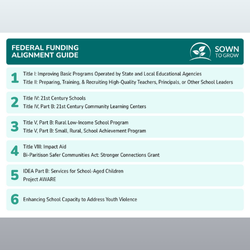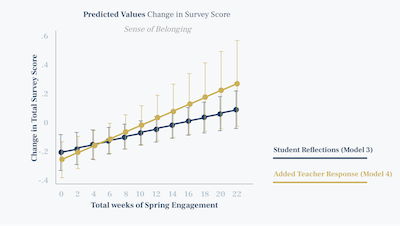The Power of Listening: How amplifying student voice can boost engagement, attendance, & achievement


Each day you navigate busy hallways filled with hundreds of students, but if you look beyond the routine chatting, scrolling, snacking, yawning, and laughing, how well do you deeply understand them?
What’s happening in their lives? What issues are on their minds? How do they feel about school?
Some students are engaged and ready to learn, while others who face more difficult circumstances are struggling with connection, motivation, grades, and more. Despite the challenges, you’re doing your best to reach them all.
As an administrator, you realize that when learners feel heard, they feel valued, and are more likely to take ownership of their education. Therefore, the ultimate goal is for this belief to be consistently and intentionally infused throughout your school’s classrooms, programs, and policies.
Although prioritizing student voice requires a thoughtful roadmap, it doesn’t have to be a heavy lift. Let’s explore the most compelling data and practical strategies on how listening to students can transform engagement, attendance, and achievement in your school.
Old & New: Why research says student voice is needed more now than ever before
The benefits of enabling students to share thoughts and feelings in academic settings isn’t breaking news. After all, John Dewey’s century-old theories have long since explained the need for pupils to be active participants in their learning. However, more modern research doubles down on the importance of student voice and its evolution over the years.
For example, according to the Quaglia Institute for School Voice and Aspirations, students who feel they have a voice at school are seven times more motivated to learn.

Along with this benefit, the report also indicates that feeling heard significantly supports students’ self-worth, engagement, and sense of purpose—all of which require even more attention following the pandemic’s residual effects on students’ depression and anxiety, chronic absenteeism, and low literacy scores.
Rather than feeling defeated by this data, one constructive way to contribute to a solution is to go straight to the source. Let’s develop best practices to check in with the students who are facing these issues, experiencing these problems, and struggling to overcome them. Let’s include them in the conversations about how to fix these broken systems.
The potential for positive outcomes of doing so is well-supported by a study published in the American Journal of Education. The piece also contained the following graphic detailing three different pathways to listen to students, create change, and make academic gains.

Students deserve a seat at the table, and many are eager for the opportunity to share, explained a Hayward United high schooler during an interview with Sown To Grow.
“I think having a student voice is important,” they said. “By having my teacher be able to better support me, I noticed a lot more motivation in my work, and I had more tools to help me in my assignments and be more comfortable at school.”
Fueled with the best evidence to validate the cause, the next step is to put knowledge into action in ways that feel accessible and manageable for all involved.
Every Voice Heard: Practical initiatives that reach all students
Implementing student voice across your school doesn’t have to happen overnight, but selecting certain ideas that feel like a good fit for your learners is a strong first step. Here are a handful of options to consider adding to your toolkit:
Classrooms
Regardless of the grade level or subject area, each individual teacher centering student voice in their own classroom is key to the mentality spreading schoolwide. Whether these practices are shared to staff in an email, discussed at a routine meeting, or role-played in a PD session, there are take-aways every teacher can use to amplify student voice:

- Morning meetings
- Student-led discussions (ex. Socratic Seminars) and decision-making (i.e. class norms and classroom rules)
- Learning choices (ex. project, presentation, or essay)
- Feedback opportunities (i.e. surveys, conferences, reflections)
- Peer teaching
- Collaborative learning groups
- Project-Based Learning (PBL)
Schoolwide Policies
No way around it, schools must have structure, and with that comes rules. However, inviting student voices to the table for policy development is one way to hopefully increase adherence. Here are a few ideas:
- Student advisory councils (Shout-out for this idea to Alum Rock Union Elementary School District, a Sown To Grow partner!—pictured below). The California Department of Education is also launching a similar program.

- Student representatives at board meetings
- In-school committees and policy discussions (ex. Student Handbook development)
- Restorative practices
- Student-led conferences (in conjunction with parent-teacher conferences)
Schoolwide Programs
Along with classes and curriculum, the community aspect of school is similarly important to students’ growth, development, future-readiness, enrichment and certainly enjoyment. Try enhancing your roster of programs with any of the following:
- Multi-Tiered Systems of Support — because student voice & belonging can be foundational inputs to MTSS, see how Sown To Grow complements Tier 1, as well as PBIS and COST programs

- Student-run clubs and events
- Youth leadership programs (i.e. Student Council, mentoring programs)
- Service-learning opportunities
- Partnerships w/ local organizations (real-world prob solving and experiences and opportunities to reflect)
- Creative outlets for expression (i.e. school newspaper, art shows, podcasts)
- Student Voice Committee (Shout-out to Chicago Public Schools for the idea!)
- Weekly check-ins (i.e. Sown To Grow: Through a simple reflective and share process, the platform provides a proactive way to support student well-being, and build scalable systems of care)

A Vibrant Path Ahead: Student voice speaks to the future of education
The ultimate hope is, as your year progresses and you continue making your daily rounds through the hallways, you can scan the crowd and confidently say that you and your school are working to reach each and every student by empowering them with a voice.
While embedding this mindset into all aspects of school life may be a gradual process, prioritizing student voice enables educators to cultivate a sense of ownership, motivation, and agency among learners that other practices cannot. Boosting engagement, attendance, and achievement are the goals one can see on paper, but the real wins happen with the overall improvement of students’ well-being.
Equipped with research-backed benefits and a variety of customizable implementation strategies, a more vibrant and welcoming learning environment can start today, grow tomorrow, and reap benefits far into the future.
--
🌱 Learn how Sown To Grow can help amplify student voice in your school or district. Click below to connect! 🌱




.png)
.png)
.png)







